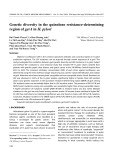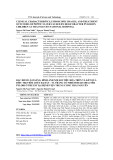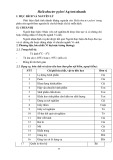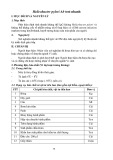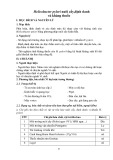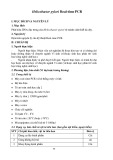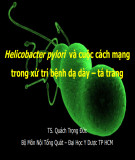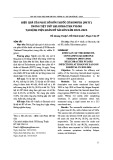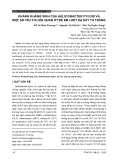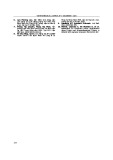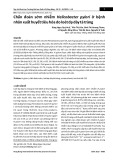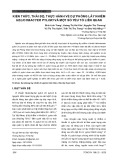M INISTRY OF EDUCATION AND TRAINING M INISTRY OF DEFENCE 108 INSTITUTE OF CLINICAL MEDICAL AND PHARMACETICAL SCIENCES DO NGUYET ANH RESEARCH ON RECRUDESCENCE AND
REINFECTION HELICOBACTER PYLORI BY
DETERMINATION OF UreCGENE IN THE DUODENAL
ULCER PATIENTS
Speciality: Gastroenterology Code: 62.72.01.43 ABSTRACT OF MEDICAL PHD THESIS Hà Nội – 2021
THE THESIS WAS DONE IN: 108 INSTITUTE OF CLINICAL MEDICAL AND PHARMACEUTICAL SCIENCES VIỆN NGHIÊN CỨU KHOA HỌC Y DƯỢC LÂM SÀNG 108
Supervisor:
1. A/Prof. PhD. Nguyen Thuy Vinh 2.A/Prof. PhD. Nguyen Thi Hong Hanh
Reviewer:
1. 2. 3.
This thesis w ill be presented at Institute Council at: 108 Institute of Clinical Medica l and Pharmaceutical Sciences Day Month Year The thesis can be found at:
1. National Library of Vietnam 2. Library of 108 Institute of Clinical Medical and Pharmaceutical
Sciences
1
INTRODUCTION
Helicobacter pylori (H. pylori) is considered to be a major cause of peptic ulcers. There are many eradication regimens for H. pyloribut there is still a recurrence of H. pylori after eradication..Many factors influence H. pylori reappearance including an important role of H. pyloriantibiotic resistance, factors of socio-economic development and environmental sanitation conditions.Helicobacter pylori (H.pylori) recurrence can be classified into two classes: recrudescence and reinfection. Recrudescence is a recurrence of the same infection after antimicrobial treatment, which occurs as first-year relapses. On the other hand, reinfection is defined as a state wherein a patient becomes infected with a new H.pylori strain after the patient went through successful eradication therapy. Distinguishing recrudescence and reinfection helps the gastrointestinal specialty have a strategic direction for treatment. That is to change treatment regimen or control risk factors. DNAfingerprinting technique is exactly distinguish between recrudescence and reinfection. PCR- RFLP and PCR sequencing determined H.pylori are two comon methods for research and clinical practice. Using above methods for UreC gene analysis is used in many studies to determine the presence of H.pylori due to its high specificity for H.pylori strains.
There have not been many studies on differentiating between recrudescence and reinfection of H.pyloriby molecular methods inVietnam. Therefore, we conduct this study for two main objectives:
1. Analysis of the rate of resistance to Amoxicillin, Clarithromycin and efficacy of Esomeprazole-Amoxicilin-Clarithromycin (EAC) regimen in Helicobacter pylori positive duodenal ulcer.
2. Determinate
the recrudescence and reinfection status of Helicobacter pylori after successful eradication treatment, by PCR-RFLP technique and UreC gene sequencing.
2
Thesis layout
The thesis has 127 pages, including: Introduction (2 pages), Chapter 1: Overview (35 pages), Chapter 2: Subjects and methods (20 pages), Chapter 3: Results (32 pages), Chapter 4: Discussion (33 pages), Conclusion (2 pages), Recommendations (1 page). The thesis has 38 tables, 4 Charts, 33 Pictures. The thesis has 190 References (19 vietnamese references and 171 english references) and 3 appendices.
The new main contributions of the thes is The recurence of H. pylori after eradication is quite common in many countries at different rates.The study identified recrudescence or reinfection in patients with H. pylori re-positive after successful eradication has important implications for the treatment strategy.This is the first study using PCR-RFLP technique and genetic sequencing to determine UreC genotype of H. pylori strains taken directly from stomach biopsy. So that distinguish recrudescence or reinfection. The results of the topic show that the rate of re-infection is higher than recrudescence in the research group. From there, posing the problem of controlling the source of H. pylori infection besides choosing appropriate treatment regimens.
CHAPTER 1. OVERVIEW 1.1.Helicobacter pyloriand duodenal ulcer
H.pyloriplays an important role in the pathogenesis of duodenal ulcer. Up to now, there are many combination treatment regimens of 3 drugs,
4 drugs including two antibiotics to eradicate H.pylori, heal ulcers and reduce
ulcers recurrence. However, antibiotic resistance, especially Clarithromycin resistance, is one of the reasons that reduce the effectiveness of first line therapy and also make it difficult to treat the next steps. 1.2. Recrudescence and Reinfection after H. pylori eradication treatment
After successful eradication treatment, H.pylori still recurence with
recrudescence or reinfection. Recrudescence means that a pre-treatment
3
strain of H.pylori has been eradicated reappeared within 12 months of follow-up or DNA fingerprinting determines identical strains. Reinfection
is the reappearance of H.pylori after 12 months of eradication treatment or
when DNA fingerprinting techniques determine difference strains before and after treatment.In developed countries, recrudescence is common,
H.pylori reinfection tends to be low in developed countries and high in
developing countries.
H.pyloricocoid
- Factors related to recrudescence: Selection of therapeutic regimen and treatment time window, re-examination diagnostic methods and time, H.pylori oral colonization, forms, H.pyloribiofilm formation
related - Factors to reinfection, individual susceptibility
to H.pyloriinfection, re-contact with H.pylori is more likely to occur when living in poor sanitary conditions, transmission H.pylori between family members when someone is infected with H.pylori.
- Significance of differentiating H.pylori recrudescenceand reinfection.
Distinguishing reinfection or recurrence plays an important role in
choosing treatment strategy, adjusting second treatment regimen, and
controlling risk factors.PCR – RFLP and PCR sequencing can distinguish subtype H.pylori strains, show the diversity of H.pylori strains. From this
feature, new research directions can be deployed such as vaccines for H
.pylori, other drug resistance mechanisms or the interaction mechanism of bacteria with H.pylori infected person. 1.3.Methods of distinguishing the genome of Helicobacter pylori and method of PCR –RFLP, sequencing determine UreC gene
- PCR- RFLP: PCR from gastric biopsy samples to diagnose H.pylori
is high specific method. There are several primers designed for gene to diagnose H.pylori. Typing UreC gene is one of the most common gene to
4
use for diagnosing H.pylori because UreC gene is only in H.pylori but not in other urease-positive bacteria. PCR typing of ureC from H.pylori
isolated from gastric biopsies have specificity from 96% to 100%. PCR
restric fragment length polymorphism (PCR-RFLP) directly from gastric biopsy of H.pylori infected patients based on restriction enzyme (HhaI,
MboI, Hind III) is a convenient and effective method of detection and
pattern of H.pylori without culture.
- Gene sequencing: Gene sequencing is to detect the order of these four nucleotides on the DNA molecule. Gene sequencing is the most accurate method of diagnosis for H.pylori. CHAPTER 2. SUBJECTS AND METHODS
2.1. Subjects 303 patients were identified with duodenal ulcer and H.
pyloripositive from 5/2012 to 5/2015 at Central Hospital E.
2.1.1. Subject selection - Patient with age ≥16 yeas old: - Diagnosis of duodenal ulcer when an ulcer image is 0.5 cm or
more, has a clear margin
- H. pylori infection with criteria: either culture is positive or both
urease test and histopathology are positive.
- The patient has not had any treatment for H. pylorieradication. 2.1.2. Exclusive criteria
- Patient has been taking antibiotics or has stopped taking it for less
than one month at the time of screening. - Taking proton pump inhibitors or quitting this medication for less than a week before gastroendoscopy. - Gastric cancer
5
- Severe gastrointestinal bleeding, pyloric stenosis, severe renal
failure, Child-pugh B or C cirrhosis - Multiple acute small ulcers 2.1.3. Research place EndoscopicDepartment – E Hospital, Gastroenterology Department, Institute of Biotechnology - Viet Nam Academy of science and technology.
p )
2.2. Methods 2.2.1. Research design:Cross – sectional study, Prospective and follow up
N
p 1( 2/ 2 ).( p
2.2.2. Sample size - Objective1: n = 303. Equation for sample size Z 1 N = sample size α = 0,05 và Zα/2=1,96 tra từ bảng Z
- Objective2:Total population samplingn = 18 2.2.3.Steps of research process
2.2.3.1. Clinical examination and data collection Clinical and laboratory data collection following patient’s report at three poit of time: 1st time is the first patient’s meet, 2nd time after treatment 45 days, 3rd time during 1 year (6,9,12 months), after 1year (>12, 18 months, ≥24 months).
- 1st time examination:evaluate clinical symptoms, gastroendoscopy to assessment of duodenal ulcer lesions,testing to diagnose H. pyloriinfection. The patient received the EAC regimen for 10 days.
- 2nd time examination:assess pain relief, side effects of medications, gastroendoscopy to assessment of duodenal ulcer healing, testing to diagnose H. pylori infection. If patient have H.pylorinegative after eradication treatment will make an appointment for examination and gastroendoscopy 3rd time after 6 months, 9 months , 12 months, 18 months, ≥24 months.
-3rd time examination:Clinical examination, gastroendoscopyto
evaluate ulcer recurrence and H. pyloriinfection. Patients haveH.pylori positive (HP+) will be tested PCR - RFLP and genetic sequencing for
H.pylori strain from gastric biopsy. At the same time PCR – RFLP and
6
genetic sequencingforH.pylori from gastri biopsy before strain treatmentwhich is stored at -200C to compare the similarities and differences ofH. pyloristrains infected before and after treatment. From
there, determine the reccrudescence or reinfection with H. pylori.
2.2.3.2. Gastroendoscopy and diagnostic H. pyloritests.
-1st Gastroendoscopyevaluate size, location duodenal ulcer. Biopsy
of 6 samples at the antrium and body is used for H. pyloridiagnostic test including rapid urease test, pathology (H&E), culture. A part of biosy sample store at -200Cfor PCR. If bacteria grow, the colonies will be transformed to antibiotic sensitive test with Amoxicillin and Clathromycin. - 2nd gastroendoscopy evaluate ulcer healing. Biopsy 4 gastric and
body samples for H. pyloridiagnostic test including rapid Urease tesr and
histopathology (H&E).
- 3rd gastroendoscopy: evaluate ulcer recurrence. Biopsy 4 gastric
and body samples for H. pyloridiagnostic test including rapid Urease tesr and histopathology (H&E) and 2 samples were stored –1960C for PCR test if the H. pyloritest turned positive again.
2.2.3.3.Culture and Antimicrobial susceptibility testing: The culture
was carried out in artificial medium on 5% blood agar under microaerobic conditions placed in an incubator of 370C for 2 to 5 days.Antimicrobial susceptibility testing by Amoxicillin and ClarithromycinE test.
2.2.3.4.PCR-RFLP UreC geneof H.pylori - 18 pairs of biopsy samples before and after treatment were
numbered
- Preparation of Genomic DNA for PCR - Determination of H. pyloriinfection by PCR technique: Amplification of UreC gene segment from DNA extracted by primer pair.
UreC - F: 5’- TGG GAC TGA TGG CGT GAG GG- 3’ UreC - R: 5’- AAG GGC GTT TTT AGA TTT TT- 3’
7
- PCR-based Restriction Fragment Length Polymorphism (RFLP) Analysis: The second PCR product was digested by enzyme HhaI, HindIII
and MboI, electrophoresis on gel agarose 1,5%,illuminated under
ultraviolet light and photographed the results.
2.2.3.5. UreC gene sequencing of H. pyloristrains infected before and
after eradication treatment: DNA extraction from gastric mucosa biopsy tissue
samples then electrophoresis of the PCR product on agarose gel.Sequencing by automatic genetic sequencing machine. 2.2.4. Research criteria 2.2.4.1. Clinical features - Age and age group, gender - Symptoms:epigastric pain, pain when hungry, heartburn, vomiting,
nausea, dyspepsia, other symptom 2.2.4.2. Endoscopic features Size of the ulcer, ulcer location, number of ulcers, healing ulcers. 2.2.4.3. Criteriaof urease, histopathology, culture, antibiotic sensitive - Urease test: posotive, negative - H.pylori density: Mild, modrate, marked - H.pylori culture: bacteria grow or not grow - Evaluate antibiotic sensitive with Amoxicillin and Clarithromycin by E-test
2.2.4.4. Assess the side effects of the drugs - Proportion of patients with and without drug side effects -Percentage of drug side effects occurring during treatment 2.2.4.5. Assess recrudescence and reinfection of H.pylori - Determination of H. pyloristrain by PCR with primer pair of gene UreC 820bp
- ReconfirmH.pyloristrain by PCR UreC gene sequencing - Compare strains before and after eradication treatment by PCR-RFLP + Recrudescence: RFLP type before and after treatment are identical + Reinfection: RFLP type before and after treatment are different - Evaluate the results of comparing infected strains before and after eradication treatment by similar UreCgene sequence of H.pylori before and after treatment.
8
2.2.5. Equipment -Endoscopy system Olympus CV180 - Urease rapid test use Kit UREASEmade in National Institute of Hygiene and Epidemiology - Histopathology (H&E) follow the process òHistopathology Department – E Hospital. - Culture bacteriain artificial blood
jelly 5% environment microaerobic atmosphere.Antibitic sensitive use E-test Amoxicilin and Clarithromycin (BioMerieux).
- PCR – ProflexTM 96- Well PCR System machine -Electrophoresis set Takara Mupid®-exu - Gene sequencing machine 3130xl (Applied Biosystems) therapy:Esomeprazole 20mg - Drugs regimen for (Nexium), Clarithromycin 500mg (Claritek), Amoxicillin 500mg (Hagimox).
2.2.6. . Statistical analysis - By medical statistical methods, usingSPSS 16.0 for Windows. - Result evaluation PCR-RFLP:
Image comparison of DNA electrophoresis tapescủaH. pyloristrains infected before and after eradication treatment with DNA maker in order toevaluationof identical and differences between H. pyloristrain.
- UreC gene sequences of H. pyloristrains were used to access the Gene Bank(BLAST-Basic Local Alignment Search Tool) comparison with sequences of correctly identified reference strains, comparing similarity between two UreC gene sequences of strains before and after treatment.
2.3. Research ethics According to regulations of the Ministry of Health and E Hospital
9
Diagnose duodenal ulcer by astroendoscopy
Positive Urease Test
Culture, Antimicrobial susceptibility testing, keep sample for PCR
Histopathology
Treat by EAC for 10 days
Ureas e Test and Histopathology negative
Ureas e Test and/or Histopathology Positive Do not choose to study
Examination and endoscopy again after 45 days to evaluate treatment results
Nội soi lại sau 6,9,12, 18, ≥24months
Urease Test and/or MBH Positive Urease Test and MBH negative
PCR – RFLP Gene sequencing Do not choose to study
Recrudescence rate of H.pylori
Reinfection rate of H.pylori
Endoscopy to evaluate ulcer recurrence
Figure 2.8. Research diagram
10
CHAPTER III. RESULTS
3.1. Evaluate of Helicobacter pylori positive duodenal ulcer (EAC) treatment with Esomeprazole-Amoxicilin-Clarithromycin regimen
3.1.1.General characteristics of the research sample - Age, gender: 51,3,8% male, 46,9%% female. The average age of patients40,9±14.The most common age group from 21 to 40 years old accounts for 51.8%
- Symptoms of epigastric pain accounted for 84.8%. - Ulcers with size 0.5 - ≤ 1cm are most common (59,7%). Frontal ulcers
are the majority(70,3%).
- The proportion of patients with mild H. pyloriinfection is 86,5%. - The success rate of H. pyloricultures was 57.8%. - The rate of H.pylori resistance to Clarithromycin before treatment was
40.6%, the rate of resistance to Amoxicillin before treatment was 24.6%.
3.1.2. Evaluate treatment outcome of EAC regimen In 303 patients, 162 patients came back to the examination and endoscopy after 45 days of treatment. Therefore, the study evaluated treatment outcomes in only 162 patients.
- 80.9% of patients have epigastric pain symptom reduction - 17.9% of patients have side effects of the treatment regimen.The rates of bitter mouth and nausea were 12.3%, insomnia headache was 1.9%, urticaria 0.6%, diarrhea 3.1%.
Board 3.10. The rate of successful eradication of H. pylori(n=162)
Res ult
Amount Success (HP - ) 110 Failure (HP + ) 52 Total 162
Ratio% 67,9 32,1 100
Comment: 67,9% of successful H. pylorieradication (H.
pylorinegative after treatment)is not high rate.
11
Board 3.11. Rate of ulcer healing (n=162) Healing ulcer res ult Total
Amount Healing ulcer 124 76,5 No healing ulcer 38 23,5 162 100 Ratio%
Comment: 76,5%ulcer healingis tỷ lệ tương đối cao Board 3.12. The relationbetween successful H. pylorieradication
and ulcer healing (n=162) Healing ulcer res ult p Healing ulcer OR (95%CI)
Success <0,01 6,91 (2,91-16,62) Failure H.pylori eradication n % n % Total 97 88,2 27 51,9 124 No healing ulcer 13 11,8 25 48,1 38
Comment: The group with successful eradication of H. pylorihad a higher rate of healing ulcer than the group that could not eradicate H. pylori(88,2% vs51,9%). The difference is statistically significant (p < 0,01). * Patients with mild H. pyloriinfection had a statistically significant difference compared with the rate of patients with moderate and severe H. pyloriinfection(p <0.01).
* Patients with mild H. pyloriinfection had a statistically significant difference in H. pylorieradication rates (86.1%) compared with the rate of patients with moderate and severe H. pyloriinfection (p <0.01). 3.1.3. Effects of resistance to Clarithromycin and Amoxicillin on efficacy of EAC regimen
Out of 162 patients who had re-examined and had a second endoscopy to evaluate the treatment results, only 141 pre-treatment patients successfully cultured and had antimicrobial susceptibility testing with Clarithromycin and Amoxicillin.Therefore, this study only evaluated the
12
effect of resistance to Clarithromycin and Amoxicillin on the efficacy of EAC regimen in 141 patients.
*When resistant to Clarithromycin, the eradication rate for H.pylori was only 38.5%. When sensitive to Clarithromycin, H.pylori eradication rate can reach 83.1%, the difference was statistically significant with p <0.01.
*When resistant to Amoxicillin, the eradication rate of H.pylori was only 59.3% and when sensitive to Amoxicillin, the eradication rate of H.pylori was 68.4%.The difference was not statistically significant with p> 0.05.
*Patient group sensitive to Clarithromycin have higher rate of healing ulcer than Clarithromycin resistant patients, respectively 88.8% compared with 55.8%, the difference is statistically significant with p <0.01.
*There were no statistically significant difference in the healing rate between Amoxicillin sensitive patient group to the Amoxicillin-res istant patient group with p> 0.05.
3.2. Recrudescence and reinfection of H. pyloriafter treatment 3.2.1. Recrudescence and reinfection of H.pyloricharacteristics of
research group
After treatment with EAC regimen, 162 patients came to follow-up for the secondexamination to evaluate the eradication status of H. pylori. Among them, 110 patients were successfully eradicated (negative H.
pyloritest). Out of these 110 patients, only 52 patients come back for third examination and gastroendoscopy at times from 6 months to 12 months or more than 12 months to assess for recrudescence or reinfection of H. pyloriand ulcer recurrence.
The number of patients come back to re-examination within 1 year is higher than after 1 year, accounting for 67.3% (35 patients). The number of patients who counted follow-up visits after 1 year was 32.7% (17 patients).
13
Số lượng (n)
Tỷ lệ %
Board 3.21. H. pylorirecurence rate after successful eradication treatment (n=52) patients HP status
Negative Possive Total
32 20 52
61,5 38,5 100
Comment: The H. pylorirecurrence rate after eradication is quite high (38.5%). Board 3.22. The H. pylorirecurrence rate and follow-up time (n=52)
HP status
Negative
Possive
OR (95%CI) Follow up time p
1,02%/year
≤ 1 year 0,74 1,22 (0,32-5,00) >1 year n % n % Total 14 40,0 6 35,3 20 21 60 11 64,7 32
Comment:The proportion of patients who reappeared with H. pyloriduring follow-up from 6 months to 1 year was 40.0%, not different from this rate of follow-up time over 1 year (35.3%) with p> 0.05 Chart 3.3. Kapplan - Meier analysis of H.pylori reappearance after successful eradication Comment:The longest follow-up time after treatment with H. pyloriwas 31
14
months. H.pylori reinfectiion rateis1,02% per year. Board 3.23. The reate of ulcer recurrence and H.pylori status after follow up time (n=52)
Ulcer status Ulcer No ulcer OR (95%CI) p HP status
Possitive <0,01 27,85 (4,39-282,60) Negative n % n % Tổng 7 35 30 93,7 37 13 65 2 6,3 15
Comment:There was a relationship between H. pylorirecurrence after eradication treatment and ulcer recurrence.Patients with H. pyloripositive after eradication treatment had a 27.85 times higher risk of ulcer recurrence (95%CI: 4,39-282,60) compared to patients with H. pylorinegative after eradication treatment, p<0,01. 3.2.2.Results of PCR-RFLP and sequencing UreC gene of H. pyloristrains infected before and after eradication treatment
Out of 20 patients with H. pylorire-positive after eradication treatment, only 18 patients analyzed the molecular biology test results including PCR-RFLP and genetic sequencing to determine the exact strain of H.pylori and differentiation between H. pyloristrains infected before and after eradication treatment. Board3.24. The rate of recrudescence and reinfection after H.
pylorieradication(n=18)
H.pyloristatus n Tỷ lệ% Tổng 18 100 recrudescence 5 27,8 reinfection 13 72,2
Comment:The rate of H. pylorireinfection is higher than the rate of recrudescence
* The rate of patients who have H. pylori recurence at the time before 1 year and after 1year did not have a statistically significant difference with p> 0.01
15
* The status of ulcer recurrence in patients recrudescence or reinfection with H. pyloridid not differ with statistical meanings with p> 0.01.
3.2.2.1.Results of PCR-RFLP analysis for UreC gene *PCR products obtained from pre- and post-treatment H. pyloristrains in 18 patients had clear, clear images of 820bp bands to ensure cut-off reaction by specific restriction enzymes and gene sequencing, so that determine the exact strain of H. pyloriand the similarity between strains.
Figure 3.4. PCR-RFLP product of patient sample from 1 to 6 PCR analysis amplified DNA fragment 820 base pair from biopsy with restriction enzymes HhaI (H), MboI (M), Hind III (Hn) of patients recurenceH. pyloriafter eradication treatment
M: DNA maker A: DNA primary infection strains B: DNA Recurence strain after eradication UreC : Product PCR of UreC gene Mbo I: Amplification of UreC DNA segment cut with Mbo I Hind III: Amplification of UreC DNA segment cut withHind III Hha I:Amplification of UreC DNA segment cut withHha I
16
. Figure 3.5. PCR-RFLP product of patient samples from 7 to 12
Figure 3.6. PCR-RFLP product of patient samples from 13 to 18
17
Comment:The results in figures 3.4, 3.5, 3.6 show that the samples 1,2,6,13,16 have DNA electrophoresis bands similar between H. pyloristrains before treatment (A) and strains after treatment (B).
* There are 5 patients (5/18) with H. pyloristrains isolated before and after treatment with similar RFLP patterns, that is patients with patient codes PCR-RFLP pair number 1,2,6,13,16 accounting for the rate of 27.8%. 13/18 patients with different types of RFLP before and after treatment accounted for 72.2%.
3.2.2.1.Results of PCR analysis UreC gene sequencing - The sequence of all 18 strains of Helicobacter pylori infected before and after treatment were identified as Helicobacter pylori when compared with the gene sequence of the reference Helicobacter pylori strains of BLAST. Thus, by the method of genetic sequencing method, the correct diagnosis rate is 100%. - The similarity on the results of genetic sequencing of 5 patients with patient codes 1,2,6,13,16 reached from 94.34% to 100%.
- Illustrative comparison of genetic sequences of two strains of H. pyloribefore and after treatment of patient samples number 1 shows the same sequence 100% (Figure 3.15)
Query: Seq_1F full Query ID: lcl|Query_21749 Length: 712 >seq_2F full Sequence ID: Query_21751 Length: 712 Range 1: 1 to 712 Score:1315 bits(712), Expect :0.0, Identities:712/ 712(100%), Gaps:0/712(0%), Strand: Plus /Plus Query 1 ATGTT TGTGA TGCGT TTGGG CATTG CGGCCGGA TTGTA TTTTA AAAAC ATTCT AAACG AA 6 0 |||||||||||||||||||||||||||||||||||||||||||||||||||||||||||| Sbjct 1 ATGTTTGTGATGCGTTTGGGCATTGCGGCCGGATTGTATTTTAAAAACATTCTAAACGAA 60 Query 61 TAAATTTTAATTGGTAAGACACCAGAAAAAGCGGCTATATGGTAGAAAACGCTTTAGTGA 120 |||||||||||||||||||||||||||||||||||||||||||||||||||||||||||| Sbjct 61 TAAATTTTAATTGGTAAGACACCAGAAAAAGCGGCTATATGGTAGAAAACGCTTTAGTGA 120 Query 121 GCGCTTTAACTTCCATAGGCTATAATGTGATCCAAATAGGACCTATGCCCACCCCTGCAA 180 |||||||||||||||||||||||||||||||||||||||||||||||||||||||||||| Sbjct 121 GCGCTTTAACTTCCATAGGCTATAATGTGATCCAAATAGGACCTATGCCCACCCCTGCAA 180 Query 181 TTGCGTTTTTAACCGAAGACATGCGCTGTGATGCGGGTATTATGATAAGCGCAAGCCACA 240 |||||||||||||||||||||||||||||||||||||||||||||||||||||||||||| Sbjct 181 TTGCGTTTTTAACCGAAGACATGCGCTGTGATGCGGGTATTATGATAAGCGCAAGCCACA 240 Query 241 ACCCTTTTGAAGATAATGGTATTAAGTTTTTCAATTCTTATGGTTATAAGCTTAAAGAAG 300
18
|||||||||||||||||||||||||||||||||||||||||||||||||||||||||||| Sbjct 241 ACCCTTTTGAAGATAATGGTATTAAGTTTTTCAATTCTTATGGTTATAAGCTTAAAGAAG 300 Query 301 AAGAAGAAAAAGCGATTGAAGAAATCTTTCATGATGAAGAATTACTGCATTCTAGCTATA 360 |||||||||||||||||||||||||||||||||||||||||||||||||||||||||||| Sbjct 301 AAGAAGAAAAAGCGATTGAAGAAATCTTTCATGATGAAGAATTACTGCATTCTAGCTATA 360 Query 361 AAGTGGGCGAGAGCGTCGGTAGCGCTAAAAGGATAGACGATGTCATAGGGCGCTATATCG 420 |||||||||||||||||||||||||||||||||||||||||||||||||||||||||||| Sbjct 361 AAGTGGGCGAGAGCGTCGGTAGCGCTAAAAGGATAGACGATGTCATAGGGCGCTATATCG 420 Query 421 TGCATTTAAAACACTCTTTCCCCAAACATTTGAATTTACAGAGTTTAAGGATCGTGCTAG 480 |||||||||||||||||||||||||||||||||||||||||||||||||||||||||||| Sbjct 421 TGCATTTAAAACACTCTTTCCCCAAACATTTGAATTTACAGAGTTTAAGGATCGTGCTAG 480 Query 481 ATACCGCTAATGGCGCGGCTTATAAGGTGGCTCCGGTAGTTTTTAGCGAGCTTGGGGCTG 540 |||||||||||||||||||||||||||||||||||||||||||||||||||||||||||| Sbjct 481 ATACCGCTAATGGCGCGGCTTATAAGGTGGCTCCGGTAGTTTTTAGCGAGCTTGGGGCTG 540 Query 541 ATGTTTTAGTGATTAATGATGAGCCTAATGGGTGTAATATTAATGAGCAATGCGGGGCTT 600 |||||||||||||||||||||||||||||||||||||||||||||||||||||||||||| Sbjct 541 ATGTTTTAGTGATTAATGATGAGCCTAATGGGTGTAATATTAATGAGCAATGCGGGGCTT 600 Query 601 TACACCCTAACCAATTGAGCCAGGAAGTGAAAAAATACCGTGCGGATTTGGGCTTTGCTT 660 |||||||||||||||||||||||||||||||||||||||||||||||||||||||||||| Sbjct 601 TACACCCTAACCAATTGAGCCAGGAAGTGAAAAAATACCGTGCGGATTTGGGCTTTGCTT 660 Query 661 TTGATGGTGATGCTGATAGGTGGTGGTGGGGATAATTAGGGAATATCGTGCA 712 |||||||||||||||||||||||||||||||||||||||||||||||||||| Sbjct 661 TTGATGGTGATGCTGATAGGTGGTGGTGGGGATAATTAGGGAATATCGTGCA 712 Figure 3.15. Comparison of H. pyloristrains before and after treatment (Patient No.1)
CHAPTER 4. DISCUSSIONS
4.1. General characte ristics of study patients The average age is 40.9 ± 14 years.The rate of infection between men and women is 1.13 / 1 (51.3% male and 46.9% female).The age group from 21 to 40 years old accounts for the highest proportion (51.8%).This is the working age.
The most common symptoms of epigastric pain accounted for 84.8%, ulcers. 0.5 - ≤ 1cm, accounting for 59.7%. Ulcers with size ≥ 1cm, frontal ulcers accounted for 70.3% similar to other studies.Ulcer 1.5cm accounts for 38.6% higher than other studies. May be most patients with obvious pain symptoms come to the examination. Mild H. pyloriinfection
19
accounts for a high proportion (75.3%).The successful culture rate of H. pyloriwas 57.8%.The rate of resistance to Clarithromycin and Amoxicillin of H.pylori before treatment was 40.6% and 24.6%, higher than the these antibiotic resistance rate studies published in Viet Nam and abroad, reflecting an increase in Clarithromycin and Amoxicillin resistance in the study area.
4.2. The therapeutic effect of EAC regimen in the treatment of
duodenal ulcers
-The rate of complete ly cessation of epigastric pain reaches 80.9%, similar to previously published studies. The successful H. pylorieradication rate ofEAC regimen was 67.9%(Board 3.10) lower than previously published studies. Eradication result is low due to the effect of high rate of resistance to Clarithromycin.
the rate of healing is statistically higher than
- The rate of scar healing is 76.5%.If H. pylorieradication is if H. successful, pylorieradication fails.Treiber and Lambert synthes ized 60 different studies with a total of 4329 patients showed that successful H. pylorieradication treatment increased the rate of ulcer healing with odds ratio (OR) ranging from 4.2 to 7,4. Patients with mild H. pyloriinfection have a higher rate of H. pylorieradication than patients with moderate to severe infections(Board 3.14), the difference was statistica lly significant with p <0.01.
Our results are similar to results of Lai et al studies, showing that the successful eradication rate of H. pyloriin the group of patients with mild H. pyloriinfection is 100% and the healing rate is 100%. Meanwhile, these two rates in the group with severe H.
pyloriinfection were 69.7% and 77.8%, respectively.
- Effect of antibiotic resistance on treatment efficacy of three EAC
regimens
+When H. pyloristrain was sensitive to Clarithromycin,
the eradication rate was 83.1%.Meanwhile, the success rate of H.pylori eradication of EAC regimen is only 38.5%. when there is resistance to
20
Clarithromycin. The difference is statistically significant with p <0.01. H. pyloriantibiotic resistant also reduces the ability to heal ulcers.
is only 29/52 patients (55,8%). H.pylori resistance
Healing rate in patients sensitive to Clarithromycin is 79/89 patients (88.8%), whereas in patients with clarithromycin res istance, the rate of to healing Clarithromycin before treatment decreased the ability to heal ulcers, the difference was statistica lly significant with p <0.01.Thus, Clarithromycin resistance affects effectiveness of H.pylori eradication and ulcer healing similar to published studies.
+ In the group of patients susceptible to Amoxicillin, the eradication rate of H. pyloriwas higher than that of patients with resistance to Amoxicillin (68.4% versus 59.3%).However, the difference was not statistically significant with p> 0.05.The rate of susceptibility to Amoxicillin is still high at 75.4%. Thus, the level of resistance to Amoxillin in our study is s imilar to many studies showing that Amoxillin is an antibiotic with a lower resistance rate than Clarithromycin resistance.
4.3.Distinguish recrudescence or reinfection of Helicobacter pylori after successful eradication treatment by PCR-RFLP technique and UreC gene sequencing PCR
4.3.1. H. pylorirecurence rate after successful eradication reatment The rate of H.pylori recur of patients in patients with successful eradication of H.pylori was 38.5% higher than published studies.Wheelon et al research in Vietnam found the recurence rate of H.pylori was 23.5%.
The rate of H. pylorirecurence in the period ≤1 year and over 1 year did not have a statistically significant difference with p> 0.01 (Board 3.22).Chart 3.3 analyzing the rate of patients withH. pyloritest returning positive after successful eradication using Kapplan-Meier graphs monitored for more than 1 year showed the H. pylorirecurence rate was 1.02% / year.This rate is higher than published studies.Susumu Take et al followed 1609 patients after successful H. pylorieradication with an average time of 4.7 years, seeing the rate of re-positive for H. pyloriwas 0.34% / year.Ji
21
Hung Nam et al found H. pylorirecurence rate of 0.91% / year with a 5-year follow-up period of 647 patients.Studies of foreign authors have a large number of patients and a longer follow-up period than our own.
4.3.2. Duodenal ulcer recurrence rate Patients with ulcer healing but recurrent ulcer have the rate of 26.1% higher than the rate of previously published studies.Wheelon et al found that the rate of ulcers recurrence was 10.2%.
4.2.3. The results of differentiating between recrudescence and reinfection after successful eradication treatment of H. pylori
Only 18 out of 20 patients were able to analyze PCR-RFLP for UreC gene of strains isolated directly from biopsy samples before and after treatment.
* Results differentiating H.pylori recrudescence and reinfection by PCR- RFLPmethod to identify UreC gene.
- 36 stomach biopsy samples of 18 patients (pre-treatment and post- treatment) were analyzed DNA fragment 820 base pairs of UreC gene.PCR results showed that all samples showed UreC gene products with 820bp.Thus, 100% of samples in our study were diagnosed with H. pyloriby PCR method with positive results. This result is similar to the study of Silvia et al using PCR method to determine UreC gene of H.pylori from 141 stomach biopsy samples, a lso found 100% positive results equivalent to the culture method.
- Result of recrudescence and reinfection of H.pylori: The PCR products of the patient samples are amplified and then digest with restriction enzymes HhaI, MboI và HindIII. Results 36 electrophores is samples (Picture 3.4-3.5-3.6) shows that 5/18 pairs have the same pattern of RFLP (recrudescence) accounting for 27.8% and 13/18 pairs have different pattern (reinfection) accounting for 72.2%.The reinfection rate is higher than recrudescence in our study are similar to those published in some developing countries. Research Leal-Herrera et al in Mexico had 75% reinfection, The study of Gisselle Soto et al in Peru had a reinfection rate of 79%.High reinfection rates are associated with re-exposure to sources of
22
infection from H. pylorior H. pyloriinfected family members residing in the patient's own oral cavity as the source of reinfection and the source of H. pyloriinfected water. Recrudescence relates to the ineffective treatment regimen, the coccoid form of H. pylori, the accuracy of the H. pyloridiagnostic method after eradication therapy. * Results differentiating recrudescence and reinfection of H. pyloriby
UreC gene sequencing method
To confirm that H. pyloriis correct, we sequence the genome of 36 biopsy samples. The analysis results of BLAST (Basic Local Alignment Search Tool) 36 sequences showed that all genes are gene segments similar to those of H. pyloristrains identified in the gene bank. This result is similar to the study of Menoni et al using PCR and diagnostic sequencing to determine H. pylorifrom biopsy fragment. They found all DNA samples of the patient analyzed by sequencing are UreC segments of the strainH. pylorihas been described in the gene bank (Gene bank).Comparing the sequences of pre- treatment and post-treatment infected strains in 5 patients with the same pre and post-treatment PCR-RFLP results showed the similarity from 94.3% to 100%. The differences in the sequence of strains before and after successful eradication of this group of patients tended to be as low as 0% to 5.66%.The differences in the sequence of strains before and after successful eradication of this group of patients tended to be as low as 0% to 5.66%.The comparison results of the remaining 12 sequence pairs had the similarity of the sequence before and after the eradication treatment from 86.85 to 94.4%.The difference in sequence tends to be as high as 5.6% to 13.15%. A sequence pair cannot be compared due to a short sequence.
23
CONCLUSIONS
Through the study on the treatment efficacy of Esomeprazole- Amoxicillin-Clarithromycin regimen (EAC) in 303 patients with H.pylori- positive duodenal ulcer and assessment of recrudescence and reinfection of H. pyloriinfection after treatment I draw some their eradication conclusions later
1. Helicobacter pylori positive duodenal ulcer treatment with
EAC regimen
- The successful eradication rate for H. pyloriwas 110/162 (67.9%). - Rate of healing of ulcers is (124/162) 76.5% - Resistance to Clarithromycin and Amoxicillin affects treatment results. + The H.pyloriresistance rate to Clarithromycin before treatment by
culture method and Antimicrobial suseptive test was 40.6% .
+ The eradication rate ofH. pylori decreased statistically with p <0.01 when there was resistance to Clarithromycin: When there was resistance to Clarithromycin, the eradication rate of H. pylori was only 38.5%, when sensitive to Clarithromycin. eradication of H. pylori can reach 83.1%.
+ The group of patients sensitive to Clarithromycin has a higher rate of uler healing than the Clarithromycin resistant group, respectively 88.8% compared to 55.8%, the difference is statistically significant with p <0.01. + The H.pylori resistance rate to Amoxicilin before treatment by
culture method and Antimicrobial suseptive test was 24,6%.
+ When resistant to Amoxicillin, the eradication rate for H. pylori was 59.3%, and when sensitive to Amoxicillin, the eradication rate of H. pylori was 68.4%. The difference was not statistically significant with p> 0.05.
+ Amoxicillin sensitive patients had no statistica lly significant difference in the healing rate compared to the Amoxicillin-resistant group with p> 0.05.
24
2. Recrudes cence or reinfection status of Helicobacter pylori after successful eradication treatment using PCR-RFLP technique and UreC gene sequencing - The rate of H. pylorirecurence after successful eradication and long-term
follow-up after eradication was 38.5%. - The rate of H.pylori rec urence by Ka pplan-Meier analysis was
1.02% per year - The recrudescence rate was 27.8% and reinfection rate was 72.2%.
The rate of H. pylorireinfection is higher than recrudescence. - There was no difference in recrudescence and reinfection rates of H.
pyloriat follow-up times before 1 year and after 1 year. - Diagnosis of H.pylori by PCR technique and UreC gene sequencing then compare with similar gene of H.pylori in gene bank by BLAST program, giving 100% accuracy.
RECOMMENDATIONS 1. The efficacy treatment
of Esomeprazole-Amoxicillin- Clarithromycin (EAC) regimen in the study area is not high due to the high rate of Clarithromycin resistance. So that doctors should consider this regimen as first-line for Helicobacter pylori positive duodenal ulcer treatment. Therefore, Clarithromycinantimicrobial Susceptibility Testing should be done before choosing this antibiotic in the treatment regimen.
2. With a higher rate of reinfection than recrudescence Helicobacter pylori, besides choosing an effective treatment regimen for Helicobacter pylori, we need to control the source of this infection well.
3. In the future, it is necessary to have research to assess the relationship between factors affecting recurrence and re-infection and the rate of recurrence and recurrence of Helicobacter pylori in Vietnam.
LIST OF PUBLISHED ARTICLE RELATING TO THESIS 1. Đo Nguyet Anh, Nguyen Thuy Vinh, Nguyen Thi Hong Hanh, (2016), “Prevalence of H.pyloriresistance to Clarithromycin of duodenal ulcer patients treated by Esomeprazole- Amoxicillin- Clarithromycin in E Hospital”, Journal of 108 - Clinical Medecine and Pharmacy, 11: 320-324.
2. Đo Nguyet Anh, Nguyen Thuy Vinh, Nguyen Thi Hong Hanh, Nguyen Dieu Thuy (2019), “Recrudescence or reinfection of H.pylori of duodenal ulcer patients after eradication in E Hospital”, Journal of 108 - Clinical Medecine and Pharmacy, 14 (7): 24-29.

